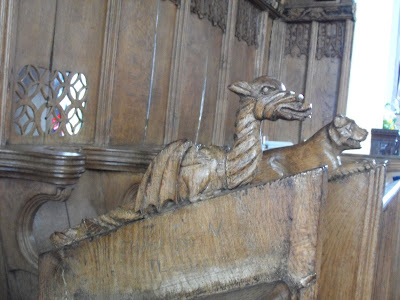Apologies for the delay in getting this all set up but I've had a busy week, with a Horspital appt, blood tests etc and offspring visiting and leading me astray with celebratory red wine! Anyway, hopefully I will be able to post a few more photos today without having to store them on Picasa first!
I fell in love with this little dragon carving on the Misericords (top photo). Like the Jesse figure, he dates from the 15th Century. I think this lion-headed one is an English dragon. He looks like his head and possibly wings have been cut off and then stuck back on or even re-carved (bless them) - perhaps the ravages of the Cromwellian henchmen in the area. And he has friends . . .
This twisty dragon looks a nastier piece of work altogether!, although it would appear he too was decapitated at some time (and possibly lost his tail too). Perhaps this one is the fierce Welsh dragon!
Then there is a lovely Mastiff:
He is worn smooth from years of stroking . . .
Opposite him is this little lion, another one who had his head knocked off and had it replaced in later times judging by the change of colour. I love his tawny tresses. So beautifully carved.
There is a beautiful female effigy (well two actually) in the Lewis chapel, which is believed to be that of Eva de Braose, who died pursuing her tame red squirrel around the castle walls (she fell . . .) "Someone" (we can guess who was to blame) chopped that squirrel off, but she still wears the chain around her waist, to which it was attached. I forgot to get a photo as we were so stunned by the Jesse figure. Next Time.
If the name of de Braose seems familiar to you, it may be because you have read Lady of Hay by Barbara Erskine (her best book, in my opinion). I have read it several times now and it has a lot of immediacy for me, because I know the area quite well. William de Braose (who would have been a benefactor of this church) was a thoroughly nasty piece of work, for all his (sham?) piety . . .
Because of the connection between the Lords of Abergavenny and the Tudors, the Priory became the Priory Church at the time of the Dissolution of the Monasteries. The Herbert chapel was saved from damage because of Sir Richard Herbert's connection with the young Henry Tudor (they were raised at beautiful Raglan Castle together) and Henry became Henry VII after Bosworth. In the details about St Mary's on Wikipedia, Sir Richard Herbert's support of Henry Tudor at the Battle of Bosworth was noted.
Some of the stone carvings were a little . . . ambivalent? I think this was a lion, or a lamb, though it looks like a camel with modified ears too!!!
I think this was a calf (fatted or otherwise?) as it had a cow-type tail. Might be a sheep though . . . St Luke had an Ox as his symbol and St. Mark had a Lion . . .
Another photo to try and give you an idea of how large the carved animals in the footrests are. As you can see, this is one of the memorials which got hacked about a bit and two arms are missing . . .
Another one with a calf/lamb??? query over it. Though you could say that's a dog's tail . . .








I'm trying to get a sense of size/scale of the figures from the photos--some are so detailed and others seem, as you noted, 'ambivalent'--or created by a clumsier hand. Given the presence of dragons in the church, along with the more predictable lions and lambs, do you think this was an era when Christianity and older forms of culture and religion were inter-twined? Fascinating!
ReplyDeleteDefinitely - I think you would say they were still "hedging their bets"! I will have to go to Kilpeck Church again (Welsh Marches once more - look it up and be fascinated). It made me smile that only the dog survived without being - literally - "defaced"! Perhaps that wasn't considered "Pagan". The little carvings on the Misericords were a few inches high (4" or 5") and 6" long perhaps. The "footstool" carvings in stone were a goodly bit bigger - perhaps a foot or more high and 2 foot plus in length. I will go back and add a complete tomb so you can compare.
ReplyDeleteJust lovely and all the history that goes with it make sit even better.
ReplyDeletecheers, parsnip
It really is an interesting church, I always look for the misericord carvings in really old churches, some of them are absolutely fantastic. My favourite here is the fierce twisty dragon:)
ReplyDeleteBeautiful post and so interesting. Misericords are so fascinating. Interesting to read about The Lady Of Hay - I used to enjoy Barbara Erskine books but haven't read one for a while. Lady of Hay was one of my favourites.
ReplyDeleteWow some beautiful carvings there, dragons being my favourite, though the mastiff takes second best. Just love the pagan imagery there scaring the congregation half to death;)
ReplyDelete